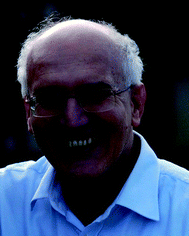Introduction to a themed issue of Chemical Society Reviews on artificial photosynthesis
Gary W.
Brudvig
 *a and
Sebastiano
Campagna
*a and
Sebastiano
Campagna
 *b
*b
aDepartment of Chemistry, Yale University, New Haven, Connecticut 06520-8107, USA. E-mail: gary.brudvig@yale.edu
bDepartment of Chemical, Pharmaceutical and Environmental Sciences, University of Messina, Piazza Pugliatti, 98166, Messina, Italy. E-mail: campagna@unime.it
“On the arid lands there will spring up industrial colonies without smoke and without smokestacks; forests of glass tubes will extend over the plants and glass buildings will rise everywhere; inside of these will take place the photochemical processes that hitherto have been the guarded secrets of the plants, that will have been mastered by human industry which will know how to make them bear even more abundant fruit than nature, for nature is not in a hurry and mankind is…
…And if our black and nervous civilization, based on coal, will be followed by a quieter civilization based on the utilization of solar energy, that will not be harmful to progress and to human happiness.”
The above lines are the last ones of the article by Giacomo Ciamician, “The Photochemistry of the Future”,1 following a lecture given by Ciamician at the Congress of Applied Chemistry in New York the same year. The wishes and hopes embedded in Ciamician's words seem to be closer to reality nowadays. Indeed, the “guarded secrets of the plants”, that is the basic mechanisms of photosynthesis, have been in large part determined in the past few decades. Thanks to the progress in studies of the mechanisms of photoinduced electron and energy transfer, as well as the development of methods to synthesize complex artificial systems (including supramolecular chemistry approaches), several steps have been made towards the goal of reaching one of the holy grails of science, that is the achievement of an effective light energy to chemical energy conversion (artificial photosynthesis), although more work is still to be done. The development of new instrumentation has allowed the application of new experimental techniques, which have enabled detailed investigations of natural and artificial systems (just to mention a few, pump–probe fs transient spectroscopies revealed the kinetics of fundamental processes, and development of X-ray crystallography unfolded structural relationships among components of natural photosynthetic assemblies), all inspiring the ingenuity of scientists towards the preparation of structurally-organized and functionally-integrated novel synthetic assemblies that can perform the basic functions of photosynthesis, to finally convert solar energy into chemical energy.
Developments in chemical synthesis, ultrafast spectroscopy, materials science and structural determination obtained in the last 15 years have paved the way for astonishing progress in artificial photosynthesis, that could not have been predicted a few decades ago. Indeed, dramatic progress has been made in recent years, and the field of artificial photosynthesis is now among the most dynamic and multidisciplinary contemporary research areas.
Actually, significant progress has been made on many of the basic components required to yield predictable artificial photosynthesis processes; examples are given in the following:
– Light-harvesting antenna (also named photosensitizers or antenna systems). These species, having the role of converting light energy into electronic energy (fundamental processes: light absorption and energy transfer), have been significantly developed recently. Progress has involved self-assembled systems, inspired by multimolecular natural systems, as well as nanoparticles, belonging to the materials science realm.
– Reaction centers. These components, aiming to convert electronic energy into redox energy by performing charge separation (fundamental process: electron transfer), also include charge separation at interfaces, where the interfaces mostly involve semiconductors and bio-inspired membranes.
– Multielectron transfer catalysts. These species, having the role of performing multielectron redox processes leading to the formation of high-energy content chemicals, in which initially absorbed light energy is stored within chemical bonds, have been designed and prepared. Both molecular catalysts and solid-state (of the materials realm) catalysts have been identified, for both oxidative and reductive processes.
Integrated systems, including all the various components mentioned above, have also been reported in the last 10 years. Many conferences have been organized on artificial photosynthesis in the last few years, and many efforts have been directed to the goal. A number of scientific journals have dedicated issues to this central theme. Because of the fast rate of progress, we feel it is useful to document the advances in knowledge with a collection of review articles, and this is the main reason for the present themed issue of Chemical Society Reviews.
This issue contains seven review articles, dealing with different aspects of artificial photosynthesis: the article by Reisner and coworkers (DOI: 10.1039/C7CS00235A) illustrates the use of photoluminescent carbon nanoparticles, carbon dots (CDs), as emerging light-harvesters for photocatalytic fuel production systems. In this tutorial review, the integration of CDs in photocatalytic fuel generation systems with metallic, molecular and enzymatic catalysts is discussed. An overview of CD types, synthesis and properties is given along with a discussion of tuneable CD properties that can be optimised for applications. Current understanding of the photophysical electron transfer processes present in CD photocatalytic systems is outlined and various avenues for their further development are highlighted.
One of the crucial bottlenecks for the design of efficient artificial photosynthesis is water oxidation, irrespective of which final chemical fuel is produced (e.g., molecular hydrogen or any reduced form of CO2). In fact, water oxidation to molecular oxygen is a four electron process, with formation of an O–O bond, a quite challenging combination of reactions. Research on water oxidation catalysts (WOCs) is, therefore, a major focus in the field of artificial photosynthesis. Meyer and coworkers (DOI: 10.1039/C7CS00465F) report the results of studies of catalytic water oxidation, going back to the first molecular WOC, the famous Ru blue dimer reported in the eighties by the same group. The mechanism of catalysis by the blue dimer is discussed along with the mechanisms of water oxidation by more efficient and robust molecular catalysts that have been developed more recently by the Meyer group. Such catalysts also include complexes of relatively cheap first row transition metals, like Cu(I) and Fe(II). Current applications with surface-bound complexes on photoanodes for water oxidation in the quite attractive and promising Dye Sensitized Photoelectrosynthesis Cells (DSPEC) are extensively illustrated. This section also reports various approaches to prepare stable interfaces containing the molecular species and semiconductor surfaces.
The review of Llobet and coworkers (DOI: 10.1039/C7CS00248C) also involves molecular catalysts for water oxidation. Their tutorial review describes the different important aspects that need to be considered to come up with efficient and oxidatively robust molecular water oxidation catalysts (Mol-WOCs). It is based on previous work by Llobet's group and completed with essential contributions from other active groups in the field. One of the issues deeply described is how the ligands can influence the properties of the Mol-WOCs: a few key examples that overall provide a complete view of today's understanding in this field are illustrated. Space is also devoted to the characterization of intermediates along the catalytic pathway for water oxidation, one of the fundamental requirements for an understanding of the effective reaction mechanisms.
The review by Patzke and coworkers (DOI: 10.1039/C7CS00306D) is organized into three main parts. First, recent highlights provide an outline of the frontiers in WOC development, such as the benefits of connecting molecular WOCs with solids along with the introduction of molecular concepts into heterogeneous WOC research, thereby integrating the molecular and materials realms. Next, a brief overview of emerging in situ/operando approaches demonstrates new options for monitoring WOC transformations. Finally, selected monitoring studies over the entire WOC dimensionality spectrum illustrate interesting cases of catalytic border crossings as new input for WOC construction.
Water oxidation is also the focus of the review by Concepcion and coworkers (DOI: 10.1039/C7CS00542C). Here, the water oxidation cycle is divided into four major steps: water oxidative activation, O–O bond formation, oxidative activation of peroxide intermediates, and O2 evolution. A significant portion of the review is dedicated to the O–O bond formation step as the key step in water oxidation catalysis: the two main pathways to accomplish this step, single-site water nucleophilic attack and O–O radical coupling, are discussed in detail and compared in terms of their potential use in photoelectrochemical cells for solar fuel generation.
Artificial photosynthesis schemes quite often include molecular systems attached to semiconductor surfaces: this is, for example, the case of photoanodes and/or photocathodes in DSPEC. Clearly, a very important point for the correct behavior of DSPEC is the robustness of the connection between the light harvesting molecular species and the semiconductor surface. The review by Materna, Crabtree, and Brudvig (DOI: 10.1039/C7CS00314E) aims to illustrate the state-of-the-art of surface anchoring groups employed to attach molecular units to photoanodes for photocatalytic water oxidation. The basic requirements for suitable and efficient anchoring are discussed. For example, it is clarified that anchoring groups must be hydrolytically stable and oxidation resistant under a variety of pH conditions. They must sometimes be electrically conducting for efficient light-induced electron injection from a photosensitizer to a metal oxide, but other times not conducting for accumulation of oxidizing equivalents on a water-oxidation catalyst. A comparison among the various anchoring groups reported so far, ranging from carboxylic acids to phosphonic acids, hydroxamic acids and silatranes, is reported. In particular, the synthesis and assembly, preferred binding modes, water stability, and electron-transfer dynamics are compared across such anchoring groups.
Gibson's review (DOI: 10.1039/C7CS00322F) addresses the development of dye-sensitized photocathodes for H2 evolution. Basic requirements for preparing efficient photocathodes are presented, with reference to reported examples covering the more recent results. Modular approaches to separately address the various problems are presented, and final integration is discussed, along with the use of advanced techniques to evaluate the performance of the devices. Current understanding of the factors governing electron transfer across the interface between the semiconductor, dye and catalyst is described and future directions and challenges for this field are outlined.
Clearly, the present themed issue is far from exhaustive, and it also reflects our personal interests. Nonetheless, we hope that the reviews included in this themed issue give a flavor of the important progress that has recently occurred in the area and will stimulate further studies. We also hope that they can be useful to inspire young researchers to join this exciting field, which has quite obvious impacts on our society, and possibly can reduce imbalance among countries. In the end, solar energy is spread out over all of the world (“Sun is for everybody”), and not concentrated in a few countries, as fossil fuels – and even uranium – are.
Notes and references
- G. Ciamician, Science, 1912, 36, 385–394 CAS.
| This journal is © The Royal Society of Chemistry 2017 |


